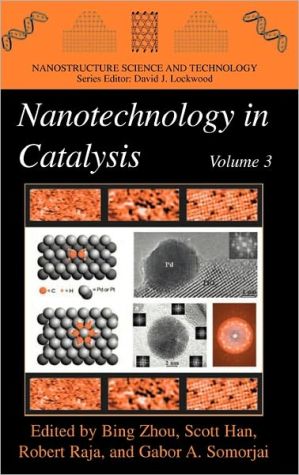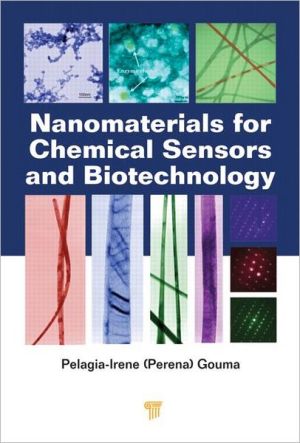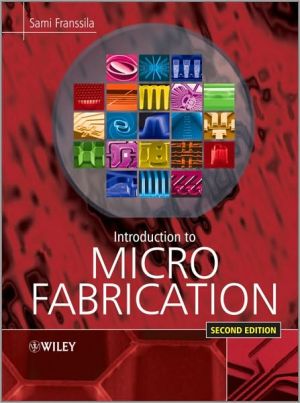Nanotechnology in Catalysis 3, Vol. 3
This book is the third Nanotechnology in Catalysis volume. Although it has been only two years since Volumes 1 and 2 were published, many new contributions and break-throughs have been made by researchers all over the world, showing the dynamic of nanotechnology in the catalysis area. This book contains the very latest information on nanotechnology development in catalysis. Topics covered include new concepts and applications of nanotechnology for catalysis, the preparation and...
Search in google:
This book is the third volume of Nanotechnology in Catalysis. Although has been only 2 years since the Volumes 1 and 2 were published, many new contributions and breakthroughs have been made by researchers all over the world, showing the dynamic of nanotechnology in catalysis area. The topics in the book are the most up-to-date information on the forefront of nanotechnology development in catalysis field. They include the new concept and applications of nanotechnology for catalysis, the preparation and characterization of nanoparticle and nanostructure catalysts, and the examples of the superior activity and selectivity achieved by using such nanocatalysts. This book provides an in-depth understanding of how nanotechnology can affect the future generation of catalyst development.This book is beneficial to a broad range of readers. It can be used as a textbook by professors and students for graduate or undergraduate curriculum. The advanced nanoscience and nanotechnology concepts are written in a textbook style to facilitate the readers who are new to this fascinating area. Researchers and engineers in industry may gain ideas on how nanoparticles and nanostructured materials can be made for and applied to industrial processes. Government officials may consult the book for understanding the new concepts and applications of nanomaterials.
Section I New Concept and Applications of Nanotechnology for CatalysisPreface ixChapter 1 Nanotechnology and Heterogeneous Catalysis Harold H. Kung Mayfair C. Kung 11.1 Introduction 11.2 Nanotechnology for Catalysis 21.2.1 Synthesis of Metal Active Sites and Oxide Active Phases 21.2.2 Environment Around an Active Site 51.2.3 Nanoreactors 61.3 Catalysis for Nanotechnology 81.4 Conclusion 9Chapter 2 Oxide-Supported Metal Thin-Film Catalysts: The How and Why Valentino R. Cooper Alexie M. Kolpak Yashar Yourdshahyan Andrew M. Rappe 132.1 Introduction 132.1.1 The Theory of Molecular Adsorption on Metal Surfaces 142.2 Methodology 152.3 Co Chemisorption to Alumina-Supported Pt Thin Films 162.3.1 Co Binding to Transition Metal Surfaces 162.3.2 Metallic Deposition on an Electronegative Support: Pt/OT 172.3.3 Correlating Chemisorption Trends with Shifts in DOS 182.4 Summary/Conclusion 19Chapter 3 Developing Catalytic Nanomotors Timothy R. Kline Walter F. Paxton Thomas E. Mallouk Ayusman Sen 233.1 Background 233.1.1 Externally Driven Methods for Movement 233.1.2 Self Driven Methods for Movement 243.2 Synthetic Catalytic Motors 253.2.1 Background 253.2.2 Fabrication of the Motor 253.2.3 Analyzing the Motor Movement 263.2.4 Mechanism for Movement 283.3 Evolution of Catalytic Motors 313.3.1 Microfabricated Motors 313.3.2 Remotely Steered Motors 313.4 Possible Applications 353.4.1 Biomedical 353.4.2 Roving Sensors 353.5 Conclusion 35Section II New Methods, Structure and Understanding of NanocatalystsChapter 4 Catalysis by Gold: Recent Advances in Oxidation Reactions Graham J. Hutchings394.1 Introduction 394.2 Background: Early Work on Gold Catalyst 404.2.1 Ethyne Hydrochlorination 404.2.2 Carbon Monoxide Oxidation 434.3 Low Temperature Co Oxidation: Nature of the Active Site 454.4 Competitive Oxidation of Carbon Monoxide in the Presence of Hydrogen 474.5 Oxidation of Alcohols 484.6 Selective Oxidation of Hydrogen to Hydrogen Peroxide 504.7 Concluding Comments 51Chapter 5 Gold Catalysts Supported on Nanostructured Materials: Support Effects Wenfu Yan Steven H. Overbury Sheng Dai 555.1 Introduction 555.2 Experimental Section 565.2.1 Preparation of Gold Nanocatalysts Supported on Anatase and Brookite 565.2.2 Preparation of Gold Nanocatalysts Supported on Mesoporous Silica Modified with Oxide Monolayer 575.2.3 Preparation of Gold Nanocatalysts Supported on Silica Modified with Oxide Double Layers 575.2.4 Measurements of Catalytic Performance for CO Oxidation 585.2.5 Characterization Methods 585.3 Results and Discussion 595.3.1 Support Effects from Structural Differences of the TiO2 Allotropes (Anatase and Brookite) 595.3.2 Support Effects from Surface-Modified Mesostructured Substrates 625.3.3 Support Effects from the Different Combinations of Oxide Monolayers Sequentially Coated on the Surface of Amorphous Silica 655.4 Conclusions 68Chapter 6 Highly Effective Nanocatalysts Prepared Through Sol-Gel Technique Guangshan Zhu Ce Wang Na Guo Xiaohui Cai 736.1 Highly Effective Sulfated Zirconia Nanocatalysts Grown out of Colloidal Silica At High Temperature 736.1.1 Introduction 736.1.2 Experimental Section 746.1.3 Results and Discussion 756.2 Ag/SiO2 Composite Nanocatalysts 816.2.1 Introduction 816.2.2 Experimental Section 826.2.3 Results and Discussion 84Chapter 7 Dendrimer Templates for Supported Nanoparticle Catalysts Huifang Lang Bert D. Chandler 917.1 Introduction 917.1.1 Traditional Routes to Supported Metal Nanoparticle Catalysts 927.1.2 Molecular Clusters as Precursors to Supported Metal Catalysts 927.1.3 Applying Nanotechnology to the Catalytic Sciences 937.2 Dendrimers and Dendrimer Encapsulated Nanoparticles (DENs) 947.3 Homogeneous Catalysis by DENs 977.4 Immobilization & Deposition of DENs 987.4.1 Deposition onto Preformed Supports 987.4.2 Sol-Gel Immobilization 997.5 Activation and Dendrimer Removal 997.5.1 Immobilized In-tact DENs 997.5.2 Activation Conditions 1007.6 Dendrimer Templated Heterogeneous Catalysts 1037.6.1 Catalysis by Platinum 1037.6.2 Bimetallic Catalysts 1057.6.3 Evaluating Support Effects 1087.7 Summary and Conclusions 110Chapter 8 Tungsten Oxide Nanorods: Synthesis, Characterization, and Application Erik H. Williamson Nan Yao 1158.1 Introduction 1158.2 Tungsten-Oxygen Chemistry 1168.2.1 Oxidation and Reduction of Tungsten and Tungsten Oxides 1168.2.2 Thermodynamic and Kinetic Properties of WOx Reactions 1188.3 Synthetic Methods to WO2.72 Nanorods 1208.4 Crystal Structure and Growth 1248.5 Applications of WO2.72 and Other Tungsten Oxides 1268.5.1 Electro-Optical Properties and Quantum Confinement 1268.5.2 Use as Gas Sensors 1298.5.3 Tungsten Oxide Nanorods as Field Emitters 1318.5.4 Tungsten Oxide as a Catalyst 1318.5.5 Tungsten Oxide and Titanium Oxide as a Heterocatalyst 1338.5.6 Tungsten Oxide and Titanium Oxide as Colloids 1348.6 Conclusion 135Section III Nanoparticles CatalystsChapter 9 Catalysis by Metal and Oxide Nanoparticles, Single Metal Atoms and Di-Nuclear Oxo-Ions in Zeolites Wolfgang M. H. Sachtler 1399.1 Introduction 1399.2 Supported Metal Clusters 1409.3 Chemical Anchoring and De-Anchoring 1439.4 Monoatomic Platinum in Zeolites 1459.5 Transition Metal Oxides and Oxo-Ions 1479.6 Conclusions 149Chapter 10 A Dual Catalytic Role of Co Nanoparticles in Bulk Synthesis of Si-Based Nanowires Ting Guo 15310.1 Background 15310.1.1 Overview 15310.1.2 Silicon-Based Nanowires 15410.1.3 Outline of This Chapter 15810.2 Experimental Details 15810.2.1 Nanoparticle Synthesis 15910.2.2 Analytical Methods 16010.3 Results 16110.3.1 Nanoparticle Deposition on Si and Al2O3 Wafers 16110.3.2 Nanowires Formation 16210.3.3 Composition of Nanowires 16710.3.4 Growth of Nanowires 17010.4 Discussion 17410.4.1 Composition and Morphology of the Silicon Nanowires 17410.4.2 Growth Mechanisms 17410.5 Future Work 178Chapter 11 Influence of Particle Size and Interaction with the Support on Redox and Catalytic Properties of Metals, Metal Oxides, and Metal Complexes Darbha Srinivas Paul Ratnasamy 18311.1 Introduction 18311.2 Supported Metals 18411.2.1 Ni-CeO2-Zr02 for Steam Reforming 18511.2.2 Au and Au-Pt Bimetallic Nanoparticles in MCM-41 for Preferential Oxidation of CO in the Presence of H2 19511.2.3 Pt-and Pd-TS-1 for Selective Oxidation 19611.3 Supported Metal Oxides 20011.3.1 CuO-CeO2-ZrO2 for Preferential Oxidation of CO 20011.4 Metal Complexes Encapsulated in Molecular Sieves 20811.4.1 Dimeric Copper Acetate Complexes 20811.4.2 Transition Metal Salen Complexes 21111.5 Summary and Conclusions 214Chapter 12 Thermo-Catalytic Oxidation of Dihydroxybenzenes in the Presence of Nanoparticle Iron Oxide Eun-Jae Shin Mohammad R. Hajaligol Donald E. Miser W. Geoffrey Chan 22112.1 Introduction 22112.2 Experimental 22212.2.1 Material and Characterization Procedure 22212.2.2 Reactor Setup and Procedure for Oxidative Cracking 22312.3 Results and Discussion 22512.3.1 Characterization of the Iron Oxide Before and After Use 22512.3.2 Decomposition of the Reactants 23412.3.3 Product Distributions 23612.3.4 Effects of Oxygen 24112.3.5 Factor Analysis 24312.4 Conclusion 252Chapter 13 Synthesis of Palladium-Based Supported Catalysts by Colloidal Oxide Chemistry Blaise Didillon Thierry Pagès Stephan Verdier Denis Uzio 25513.1 Introduction 25513.2 Synthesis of Monometallic Catalysts 25813.2.1 Synthesis of Palladium Oxide Hydrosols 26713.2.2 Synthesis of Tin Oxide Hydrosols 26713.2.3 Alumina-Supported Palladium Catalyst 27113.3 Bimetallic Catalysts Prepared by Colloidal Synthesis 27413.3.1 Palladium-Tin Catalysts 27413.3.2 Palladium-Silver Catalysts 27813.4 Application to Catalysis: Selective Hydrogenation Reactions 28013.4.1 Hydrogenation of Phenylacetylene on Pd Monometallic Catalysts 28013.4.2 Hydrogenation of Butadiene on Bimetallic Palladium-Tin Catalysts 28113.4.3 Hydrogenation of Acetylene on Bimetallic Palladium-Silver Catalysts 28413.5 Conclusion 284Section IV Nanoparticle Catalysts for Fuel Cell ApplicationsChapter 14 Gold-Based Nanoparticle Catalysts for Fuel Cell Reactions Chuan-Jian Zhong Jin Luo Mathew M. Maye Nancy Kariuki Lingyan Wang Derrick Mott Peter Njoki Mark Schadt Stephanie I-Im. Lim Yan Lin 28914.1 Introduction 28914.2 Experimental 29214.3 Characterizations of Nanostructured Catalysts 29514.3.1 Size and Composition 29214.3.2 XRD Characterization 29414.3.3 FTIR Characterization of CO Adsorption 29614.4 Electrocatalytic Activity of Nanostructured Catalysts 29814.4.1 Electrocatalytic Reduction of Oxygen 29814.4.2 Electrocatalytic Oxidation of Methanol 30014.5 Conclusion 302Chapter 15 Carbon-Supported Core-Shell PtSn Nanoparticles: Synthesis, Characterization and Performance as Anode Catalysts for Direct Ethanol Fuel Cell Luhua Jiang Gongquan Sun Suli Wang Qin Xin Zhenhua Zhou Bing Zhou 30915.1 Introduction 30915.2 Experimental Details 31015.2.1 Chemicals 31015.2.2 Preparation of Catalyst 31115.2.3 Physical Chemical Characterizations 31115.2.4 Electrochemical Characterization 31215.2.5 Single-Cell Performance Tests 31215.3 Results and Discussion 31315.4 Conclusions 322Index 325








